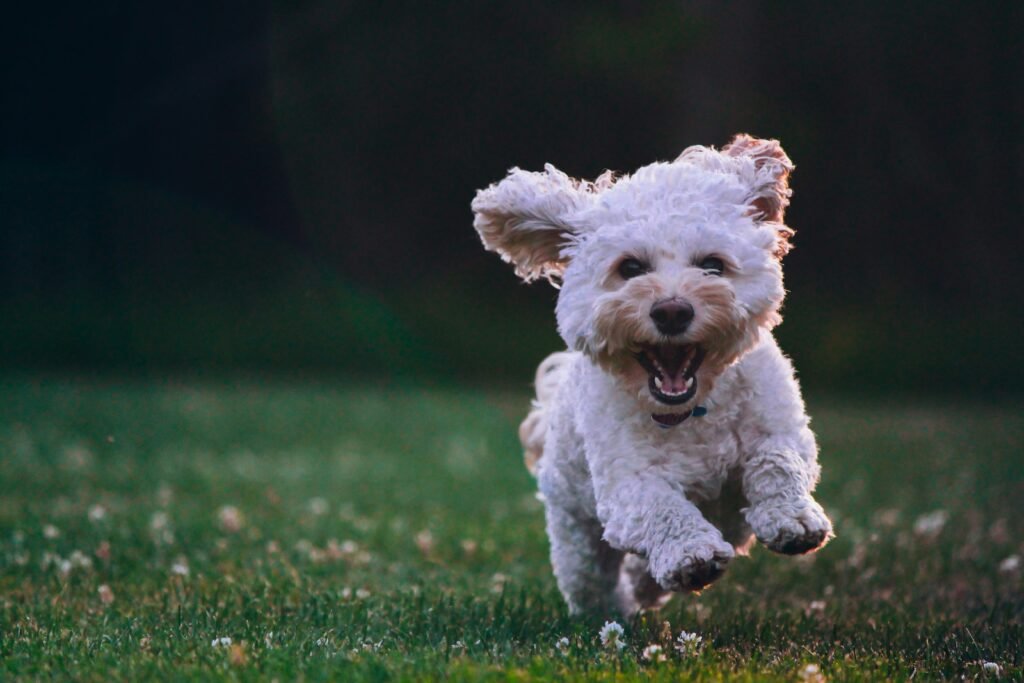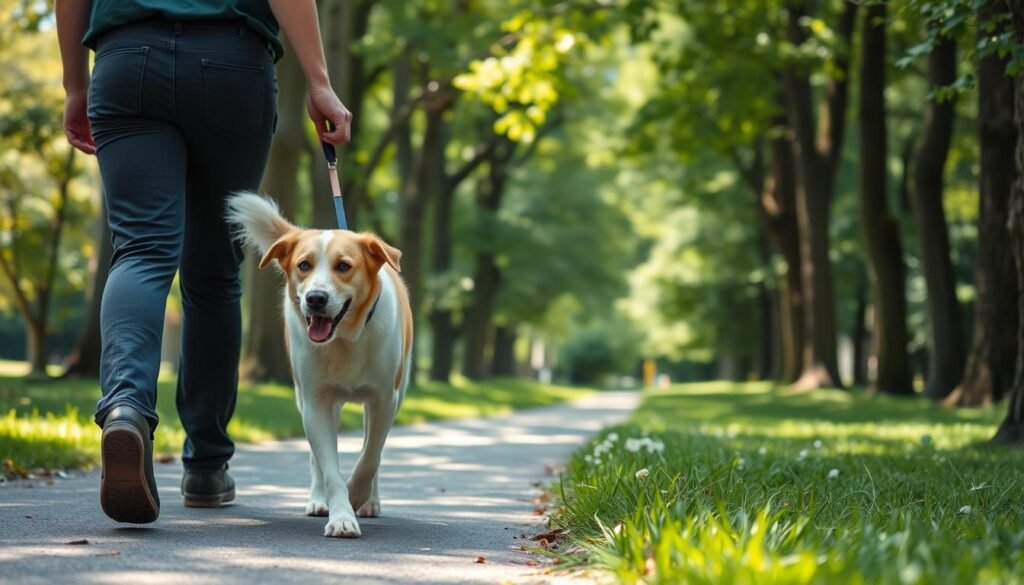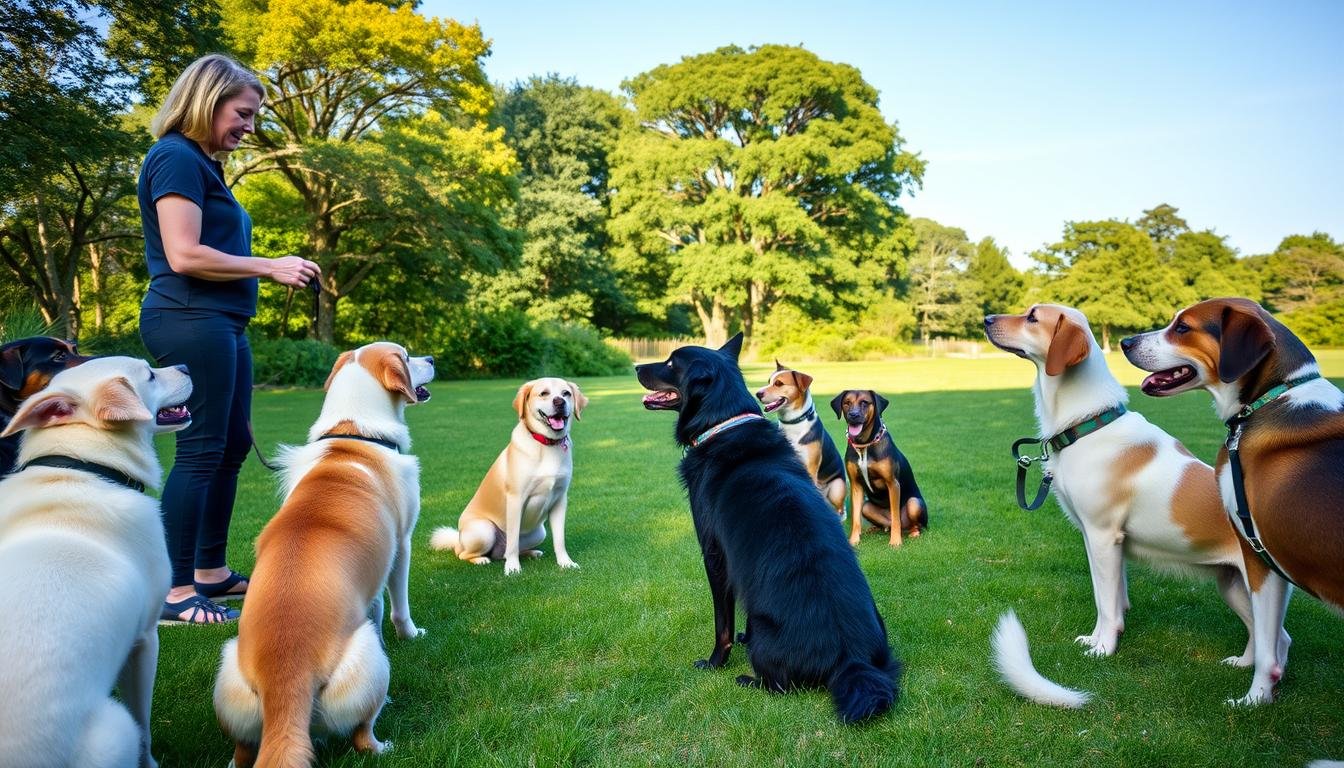Have you ever wondered why some dogs are impeccably behaved while others seem uncontrollable?
Welcome to a journey that will change how you view dog obedience training. Learn how mastering these 10 effective dog commands can change pet behavior management. It will also strengthen the bond between you and your dog. By the end of this article, you’ll see how a few simple commands can make your dog happy and well-adjusted. Let’s begin!
Quick Recommendation: Our blog is filled with tips and tricks for training your puppy or dog. If you're seeking a comprehensive training program, we recommend K9 Training Institute.
Why Teaching Commands Is Crucial for Your Dog
Teaching commands to your dog is key for many reasons. First, it boosts communication between you and your pet. This makes daily life together better and more fun. It’s a big plus of dog training.
A trained dog is safer. When they listen to commands like “Sit” or “Stay,” they avoid dangers. This could be running into traffic or meeting aggressive animals. So, training keeps your dog safe.
Also, learning commands keeps your dog’s mind active. This is as important as physical play. It stops boredom and bad behavior. Training also strengthens your bond with your pet, making your relationship better.
Moreover, trained dogs are less likely to wander off. Studies prove that dogs who know recall commands stay closer to home. This means fewer lost pets and more peace of mind for you.
In summary, teaching basic commands to your dog is very beneficial. It ensures safety, improves communication, and makes life better for both you and your pet.

How to Start Command Training
Starting dog training is both exciting and rewarding. Success comes from a good environment and effective methods. Choose a quiet spot without distractions to help your dog focus.
Positive reinforcement is key. Use treats, praise, and play as rewards for good behavior. Dogs love positive feedback, making learning easier.

Consistency is crucial. Regular sessions at the same time each day are important. Keep sessions short, fun, and end on a positive note. This builds discipline and strengthens your bond. Be patient as dogs learn at different speeds.
Get the right tools and resources. Clickers, treat pouches, and durable leashes are essential. Books and online tutorials offer valuable tips for better training.
Command: Sit
The ‘sit’ command is a key basic dog command. It’s often the first command taught in puppy training. It promotes good behavior and sets the stage for more training.

Quick Recommendation: Our blog is filled with tips and tricks for training your puppy or dog. If you're seeking a comprehensive training program, we recommend K9 Training Institute.
To start, get your dog’s attention with a treat. Hold the treat near their nose and slowly move it up. As they follow the treat, their bottom will naturally sit down.
As soon as they sit, praise them and give the treat. This positive feedback helps them learn.
Teaching ‘sit’ requires consistency. Practice several times a day, using the same command each time. Clear and consistent words are important. Be patient, especially with young puppies starting their training.
Older dogs can also learn ‘sit’. Remember, positive reinforcement is key. Reward them with praise or treats when they sit correctly. This makes the training rewarding and effective.
If your dog finds it hard to sit, try training in a quieter place. Fewer distractions help. Learning basic commands like ‘sit’ improves your dog’s behavior and your bond with them.
Command: Stay
Teaching your dog the ‘stay’ command is crucial for their safety and your peace of mind. Start with short sessions. Have your dog sit or lie down, then say “stay” while you step back slowly. Increase the distance and time to improve their patience and control.
The ‘stay’ command is key for safety and advanced obedience. It’s useful when guests come over or during outdoor fun. Short, regular practice keeps the command strong.
When teaching ‘stay’, avoid rushing or getting upset. Patience is essential. If your dog breaks the stay, calmly guide them back and say “stay” again. Training is a slow, consistent process that needs positive feedback.
With time and effort, you can use ‘stay’ in more complex obedience exercises. This improves your dog’s behavior and your bond with them. Remember, good training makes your pet better and strengthens your relationship.

Command: Come
The recall command is key for your dog’s safety and your peace of mind. It’s vital whether you’re at the park or at home. It keeps your dog from getting into danger and is a big part of training them to come back.
Make sure to link the “Come” command with good things only. Never call your dog for something bad, like a bath or vet visit. Use treats, praise, or play to make the recall command positive.
Practice the recall command at different distances. Begin with short distances and then go longer as your dog gets better. A long line can help you control your dog while they learn to come back.
Recall games make training fun and keep your dog interested. Try games like hide-and-seek or calling your dog between two people. Training in different places helps make the recall command reliable.

By using these methods, your dog will come back quickly and happily. This keeps them safe and strengthens your bond.
Command: Down
Teaching your dog the down command is key for calm behavior and submissive postures. It’s great for times when you want your dog to relax and not bother others. With the down command, your dog will stay calm in places like parks or at home.
To start, have your dog sit. Hold a treat so your dog can see and smell it. Move your hand down slowly, guiding your dog to follow the treat. Say “down” as your dog lowers its body. Give it the treat and praise once it’s down.
Keep practicing to make the command stick. Your dog will learn to lie down when you say down. This makes your dog more relaxed and obedient.
You might face challenges like your dog not listening or getting distracted. Stay patient and keep training sessions short and fun. Using voice cues and hand signals can help your dog understand the command better.
Command: Heel
Learning the ‘heel’ technique is key for a calm walk with your dog. It makes sure your dog stays right by your side. They will watch your every move and keep in step with you. This command is the first step in leash training, making walks better for both you and your pet.

Begin with short, consistent commands like “heel,” and use treats as rewards. Hold the treat near your hip to guide your dog. Change directions often and use your voice to signal, so your dog learns to follow you.
Varying your pace keeps your dog alert and responsive. This makes walks more enjoyable and stress-free.
Choosing the right gear is important for leash training. Use a sturdy harness for better control and comfort. Adjustable leashes help keep the right distance and tension. This promotes the ‘heel’ technique and makes walks more enjoyable.
Command: Leave It
Teaching your dog to control impulses is key for their safety and your peace of mind. The ‘leave it’ command helps stop them from picking up dangerous or unwanted items. It takes patience and clear communication to teach this command.
Begin by using a less appealing item and say ‘leave it.’ Reward your dog when they listen. This helps them understand the command better.
As your dog gets better, use more tempting items for training. Always use positive rewards to help them learn. This not only teaches them to leave things alone but also improves their impulse control.
With regular practice, your dog will learn to avoid picking up harmful objects. This makes your home safer and strengthens your bond with them.
Command: Drop It
Teaching your dog the ‘drop it’ command is key for safe handling of items. It helps them let go of things they pick up. This command is crucial to stop your dog from eating harmful things.
By training your dog to follow the ‘drop it’ command, you keep them safe. It also makes pet-owner interactions better when giving back items.
Start by letting your dog pick up a favorite toy or object. Then, say “drop it” clearly and calmly. Offer a treat as a reward.
Treats make your dog want to drop the object, creating a positive link. Practice this often to get better at the ‘drop it’ command.
Using clear commands helps your pet learn to give up objects safely. This builds trust and teaches them to handle items correctly. Soon, they’ll drop things even without a treat, just by hearing the command.
Command: Wait
The ‘wait’ command is key in teaching patience to dogs. It makes them safer at doors and crossings. Unlike ‘stay’, ‘wait’ is for short, specific moments.
Start teaching ‘wait’ in quiet places. Use treats at the door to teach your dog to pause. Say the command clearly and reward them when they get it right. This builds patience and reliability in your dog.
At street crossings, ‘wait’ keeps your dog safe. They learn to pause before moving, making walks safer. This habit improves obedience and safety.
Use the ‘wait’ command often to teach your dog its purpose. It’s useful at doors and crossings. This command helps your dog stay patient and safe every day.
Conclusion
Training your dog is more than just teaching commands. It’s about building a strong bond between you and your pet. Each command, from “Sit” to “Wait,” is key to a safe and happy home for both of you.
Learning these commands is just the start. Lifelong training keeps your dog’s skills sharp. Regular practice and positive feedback make your dog more obedient and happy.
Experts and dog owners agree: training is worth the effort. A well-trained dog brings joy and reliability to your life. By committing to training, you create a lifelong bond of respect and understanding. This enriches your relationship and makes your lives better.
Quick Recommendation: Our blog is filled with tips and tricks for training your puppy or dog. If you're seeking a comprehensive training program, we recommend K9 Training Institute.

